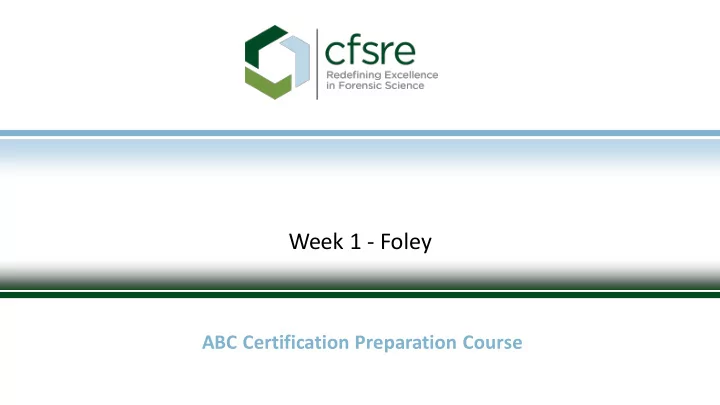

Week 1 - Foley ABC Certification Preparation Course
HISTORY – EVOLUTION OF PRACTICE & SIGNIFICANT HISTORICAL FIGURES
History of Forensic Science • Forensic Science: application of science to law – Chemistry, Biology, Pathology, Psychology, Physics, Computer Technology etc. • Many individuals contributed to the start of Forensic Science • Sherlock Holmes – the first Forensic Scientist? https://www.harpercollins.com/9780062085740/the-adventures-of-sherlock-holmes/
Mathieu Orfila – 1787-1853 • Considered one of the founders of forensic toxicology • Traité des Poisons – New techniques and improved methods for testing for poisons • Trial of Marie LaForge – Accused of murdering her husband with arsenic – Chemists performed Marsh Test and did not find any arsenic in his body – Orfila concluded they had performed the test incorrectly and was able to perform the test at the courthouse and demonstrate the presence of arsenic
Alphonse Bertillon – 1853-1914 • Devised the first scientific system for personal identification • Anthropometry – collection of body measurements for an individual’s identity – Eventually replaced by fingerprinting • “Father of Criminal Identification”
Francis Galton – 1822-1911 • First definitive study of fingerprints • Developed classification system for filing fingerprints • Published Fingerprints – Uniqueness of fingerprints – Permanence of fingerprints http://galton.org/fingerprinter.html
Karl Landsteiner & Leone Lattes • Landsteiner: discovered the ABO blood groups in 1901 • Lattes: developed procedure for determining blood groups – Began to apply to Criminal Investigations https://www.sutori.com/item/1915-leone-lattes-a-professor-at-the-institute-of-forensic-medicine-at-the-uni
Calvin Goddard – 1891-1954 • U.S. Army Colonel • Developed techniques to examine bullets using a comparison microscope
Albert S. Osborn – 1858-1946 • Father of question document examination – Emphasis on scientific examination • Questioned Documents – 1910 – Methods for the examination of documents • Founded American Society of Questioned Document Examiners (ASQDE) in 1942
Walter C. McCrone – 1916-2002 • World’s “Preeminent” microscopist • Published numerous books, journals, and created a research institute • Applied his techniques to thousands of criminal and civil cases
Hans Gross – 1847-1915 • Public prosecutor and Judge in Graz, Austria • First to describe the application of science to the field criminal investigation • Book : Handbuch für Untersuchungsrichter als System der Kriminalistik – Criminal Investigation – Microscopy, Chemistry, Physics, Mineralogy, Zoology, Botany, Anthropometry, Fingerprinting • Scientific Journal : Archiv für Kriminal Anthropologie und Kriminalistik
Edmond Locard – 1877-1966 • Education in medicine and law • Worked with Lyons PD to start a laboratory • Started with a microscope and spectrometer
Edmond Locard – 1877-1966 • Locard’s Exchange Principle – Every contact leaves a trace – Perpetrator will bring something to a crime scene and take something away • Can be used to link a person to a particular location or victim – Importance of recognizing and collecting trace evidence • Hair, fiber, paint, etc
Historical Records of Forensic Science Application • 3 rd Century China – Yi Yu Ji – Manuscript – Describes a case of a coroner’s investigations into the death of a body – Replicated the burning use pig’s corpses – Use of fingerprints for transactions • 1978 - François-EmanualFodéré – A Treatise on Forensic Medicine and Public Health
Historical Records of FS Application • 1775 – Carl Wilhelm Schelle • 1839 – James Marsh – Detection of arsenic in corpses – Use of toxicological evidence at trial • 1806 – Valentin Ross • 1853 – Detection of arsenic in walls of – Microcrystalline Test for stomach hemoglobin • 1828 – William Nicol • 1863 – Polarizing Microscope – First presumptive test for blood • 1839 – Henri Louis Bayard • 1850’s - 60’s – Microscopic Detection of – Forensic Photography spermatozoa
Forensics in the U.S. • After WWI labs formed in Vienna, Berlin, Sweden, Finland, Holland • First forensic laboratory: LAPD in 1923 LAPD Forensic Lab • FBI developed National Forensics Lab in 1932 • FBI’s Forensic Science Research and Training Center in 1981 J. Edgar Hoover
Recommend
More recommend